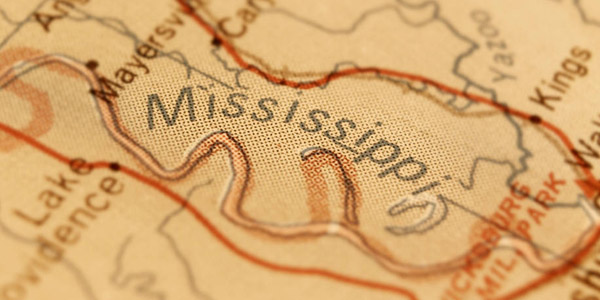
Mississippi.
The mere name of the Magnolia State can still evoke vivid and often frightening memories. The brutality of slavery in Mississippi was followed by the hopelessly unfair system of sharecropping, in which many black farmers were perpetually in debt and unable to get paid fairly for their crops. Many of the most memorable and horrifying events of the civil rights movement took place in Mississippi — the murder of three young civil rights workers and its cover-up, the assassination of NAACP Field Secretary Medgar Evers, the shooting of James Meredith on a one-man “March Against Fear” from Memphis to Jackson.
Home Grown
Blues in Mississippi arose from the crucible of plantation life and the punishing labor of picking cotton. The music expressed sorrow but also uplifted spirits much in need of positive energy. The “Mississippi Delta” isn’t really a delta; it’s a floodplain. Regular flooding had left rich alluvial deposits favorable to agriculture — as long as fields under cultivation weren’t flooded again, which required a system of levies. Building and maintaining the levies was arduous and dangerous work, and the levy camps were notoriously perilous places. In 1947 Alan Lomax recorded Memphis Slim, Big Bill Broonzy, and John Lee Williamson (the first “Sonny Boy Williamson” in blues history) talking freely about plantation and levy camp life. Although they used fake names, the recording was deemed too incendiary, and too potentially dangerous for their safety, to be issued for ten years, first appearing overseas, and concealing the names of the three men until reissues years after that. The album is called “Blues In The Mississippi Night.”
For some players, music offered extra income, and for a few, such as Charley Patton, an escape from doing farm work. Yet for many, a physical escape from Mississippi was the only answer. Blacks left the state in large numbers for many places, primarily Memphis and St. Louis in the south, and Chicago and Detroit in the north. The rural “Delta Blues” was electrified in the postwar years, and artists such as Muddy Waters, Howlin’ Wolf, Jimmy Reed, and B. B. King (who never really had a “Delta” sound) established their careers and left cotton picking far behind them.
The blues also continued to thrive in the Delta, in the fields and the juke joints, as well as the “hill country” outside of the Delta, where Mississippi Fred McDowell influenced a generation of blues players with a more repetitive and trance-inducing sound than the blues of the Delta. Among the artists who would become well-known for this style are R. L. Burnside and Junior Kimbrough.
Many blacks found better life outside of Mississippi, if not exactly the “promised land” of life without racism, but for some it didn’t work out. R. L. Burnside returned to Mississippi after two members of his family were killed in Chicago in separate incidents. Burnside ran a juke joint for a while, but, from recordings, his music was better known in Europe than here in the United States, until his surprise late-in-life success here that saw his music on TV shows and in movies. His music was featured in the film “Big Bad Love” (as well as a cameo performance appearance) and on TV on “The Sopranos.”
Juke Joints
The juke joint scene in both the Delta and the hill country was musically rich, though the clubs, as described in Bill Coday’s song “Country Back Hills Juke Joint,” could be pretty rough-and-tumble places. There were good reasons why some clubs were called “a bucket of blood” club. As the clientele for the joints aged, the violence diminished and a growing tourist industry became significant to their operation and the proliferation of the music. Sadly, in this century, the juke joint scene has been in substantial decline as casinos have arisen in Mississippi, and small club owners have chosen to hire deejays more often than live bands.
The 2012 film “We Juke Up In Here” explores the state of Mississippi juke joints and presents music recorded in one club that is thriving, Red’s Lounge in Clarksdale, MS. While many of the players are senior citizens, there are some younger ones, including “Big A” (Anthony Sharrod), who is in the film, and Marquise Knox, who lives in St. Louis but has close ties to his family’s home in Granada, MS. Filmmakers Jeff Konkel, Roger Stolle, Damien Blaylock, and Lou Bopp carefully avoid pronouncing Mississippi blues dead or saying that it is on death’s door. (To be sure, this is an old and oft-repeated promotional ploy. Big Bill Broonzy, one of the first blues singers to tour in Europe, back in the 1950s, was sometimes billed as the “last of the great blues singers.”)
The Delta Today
Clearly, though, this is a time of transition, and what the old players can bring to us of the magic of Mississippi blues, the elusive grasp of pitch, texture, tone, and timing that is far more important than mere technical virtuosity in the blues, and the transcendent spirit of the music, is something of priceless value.
The state of Mississippi and its local communities have recognized the great cultural treasure that grew there, even though recognizing and celebrating it necessitates acknowledging the horrors that gave rise to it. With reverence for the trailblazers of the past and an eye on the future, they have established the Mississippi Blues Trail with markers throughout the state. The Delta Blues Museum in Clarksdale and the B.B. King Museum and Delta Interpretive Center in Indianola present the Mississippi blues and its story as well, a story of music and human understanding unparalleled in cultural history.
{ 0 comments }

